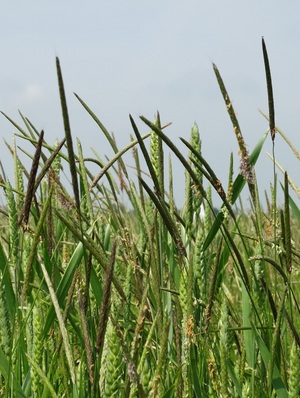We may have voted to leave the EU but black-grass has decided to remain. It is hard to generalise but for many, particularly those who have yet to grasp fully the enormity of the problem, there has been a backward step this year in its control in winter wheat. Some farmers still have a rather touching faith in what herbicides can achieve.
In many situations the pre-em/early post-em herbicides gave good control of black-grass plants in the autumn. However, the survivors grew strongly in the warm autumn/winter conditions and established more  tillers than perhaps could reasonably be expected. In addition, in some areas wet soil conditions meant that crop competition was disappointing, particularly in the poorer drained parts of fields.
tillers than perhaps could reasonably be expected. In addition, in some areas wet soil conditions meant that crop competition was disappointing, particularly in the poorer drained parts of fields.
There are instances where just a couple of weeks delay in drilling has had a remarkable effect on black-grass populations. The critical period in many areas was when drilling had been delayed from the beginning of October to mid-October. Soils were moist and obviously there was a high emergence of black-grass during that period. Crops drilled in the middle of the month rapidly established and provided good crop competition. The later drilling would also have helped the efficacy of the herbicides.
Conditions for the spring establishment of cereals were not as favourable as in the previous four years, particularly on the really heavy soils. This resulted in later drilling dates, which may theoretically have been advantageous in terms of black-grass control. Despite the later drilling dates, there was often sufficient moisture for the soil residual grass weed herbicides. Hence, herbicide use in spring barley provided good reductions in black-grass numbers where there was good crop competition. The issue in spring wheat was the restricted herbicide options for black-grass control. This, I hope, will be rectified in the coming seasons.
Personally, I am not in favour of delaying spring drilling of cereals in order to take full advantage of black-grass emergence prior to drilling. In my opinion, it is far better to drill as soon as conditions allow in order to maximise the possibility of soils being moist for the residual herbicides and to help ensure that the spring cereal is competitive. In addition, residuals are more likely to be ‘hot’ in the warmer conditions that tend to prevail later in the spring.
For the first time in three years I am not aware of any instances of exceptional numbers of black-grass emerging in spring drilled crops. It tends to confirm my suspicion that this phenomenon was due to the cold and wet summer of 2012 resulting in ‘super-dormant’ seed being set. It seems that it has taken three seasons to clear the back-log. In parts of Eastern England the last few weeks have been cold and wet. Hopefully it will turn warmer in the near future to ensure that we do not go through the same experience again.
So what has another season’s experience taught us? I think it has confirmed that many farmers and advisers need to assess more carefully the threat of black-grass to next year’s autumn sown crops. There is no point in taking an unrealistic view of what herbicides can achieve. In many instances the background population of black-grass needs to be reduced to a level where herbicides can prevent yield loss and also provide the best chance of limiting seed returning to the soil. This means that there should be the potential of no more than 10 black-grass plants/m² (at a push 15/m²) emerging in an untreated winter cereal crop. Such numbers do not occur in an autumn sown cereal where there is so much black-grass emergence between the previous and the current crop that at least two applications of glyphosate are required in order to prevent emerged black-grass plants reducing further emergence through competition (no, it is not allelopathy). In such situations, winter or spring drilling are the only options.
All farmers and advisers are aware of the cultural options available and attention to detail is essential, such as estimating where in the soil profile the majority of the viable black-grass seed lies. This should help to guide the choice of type and depth of cultivation required. All approaches should be considered, including hand and chemical roguing.
I constantly witness the value of the strategic use of the plough. Now, please do not get back to me and say that ploughing would ruin the soil after many years of adoption of non-plough tillage. I have never seen any trials or field evidence to support such a statement. All options have to be considered!
